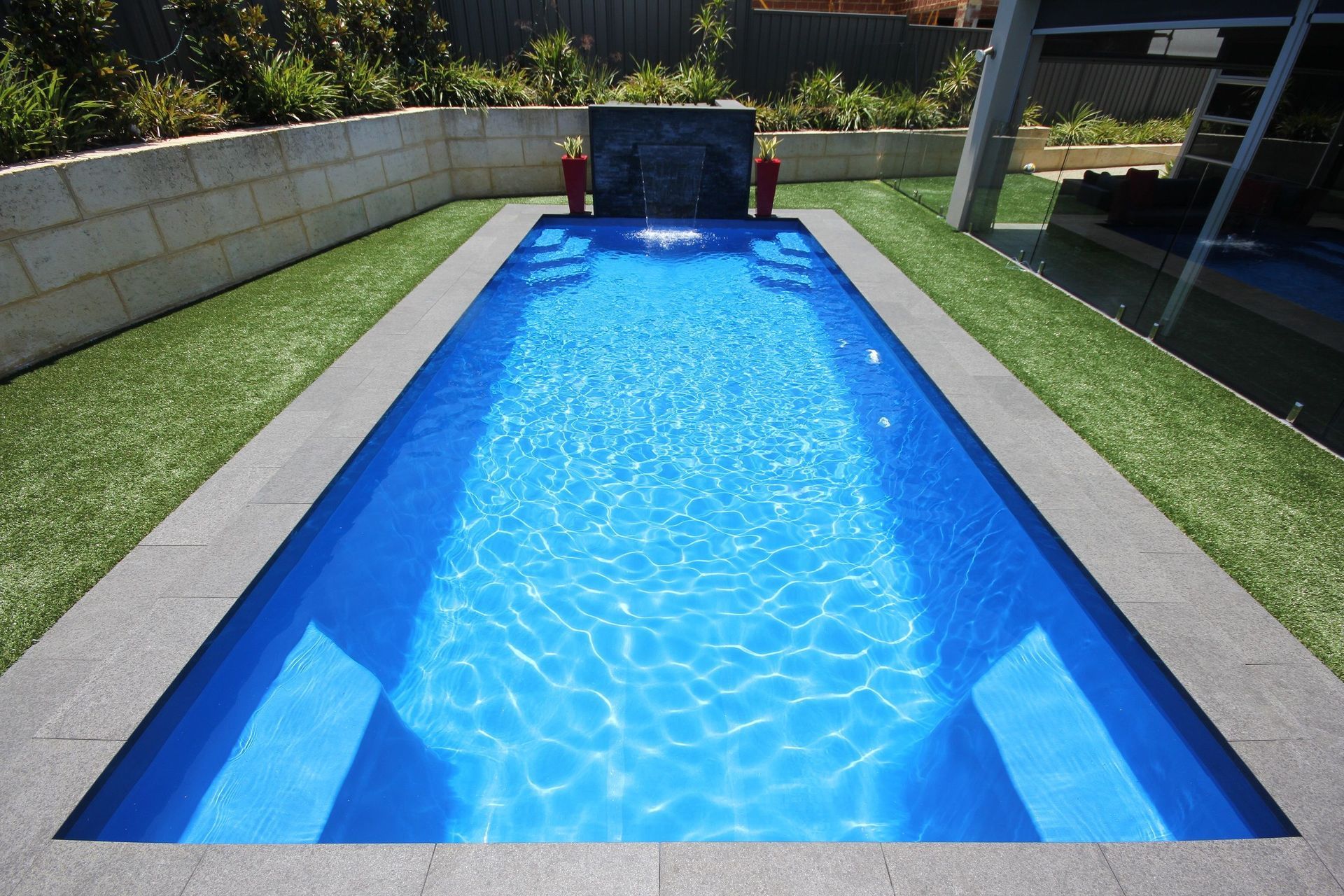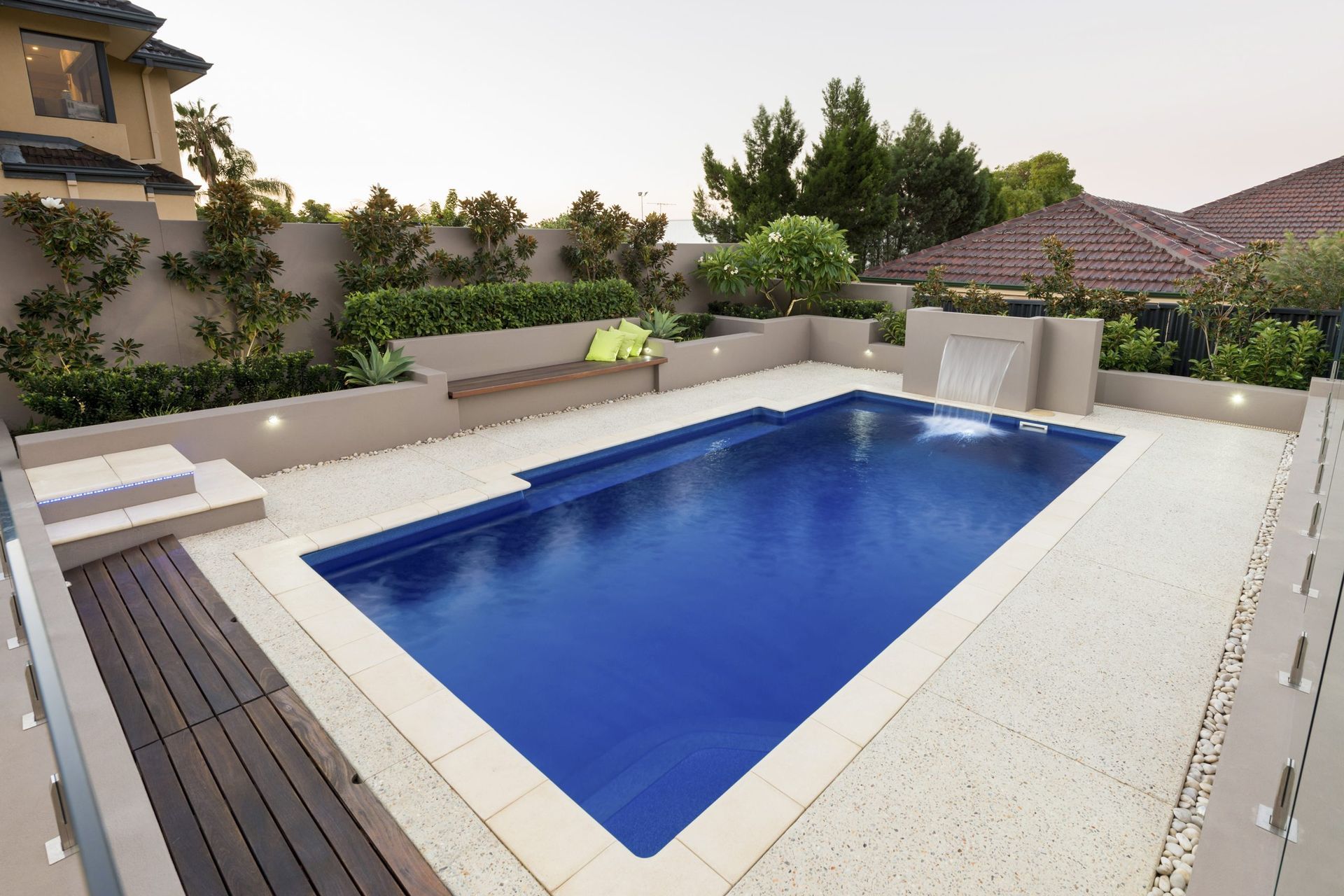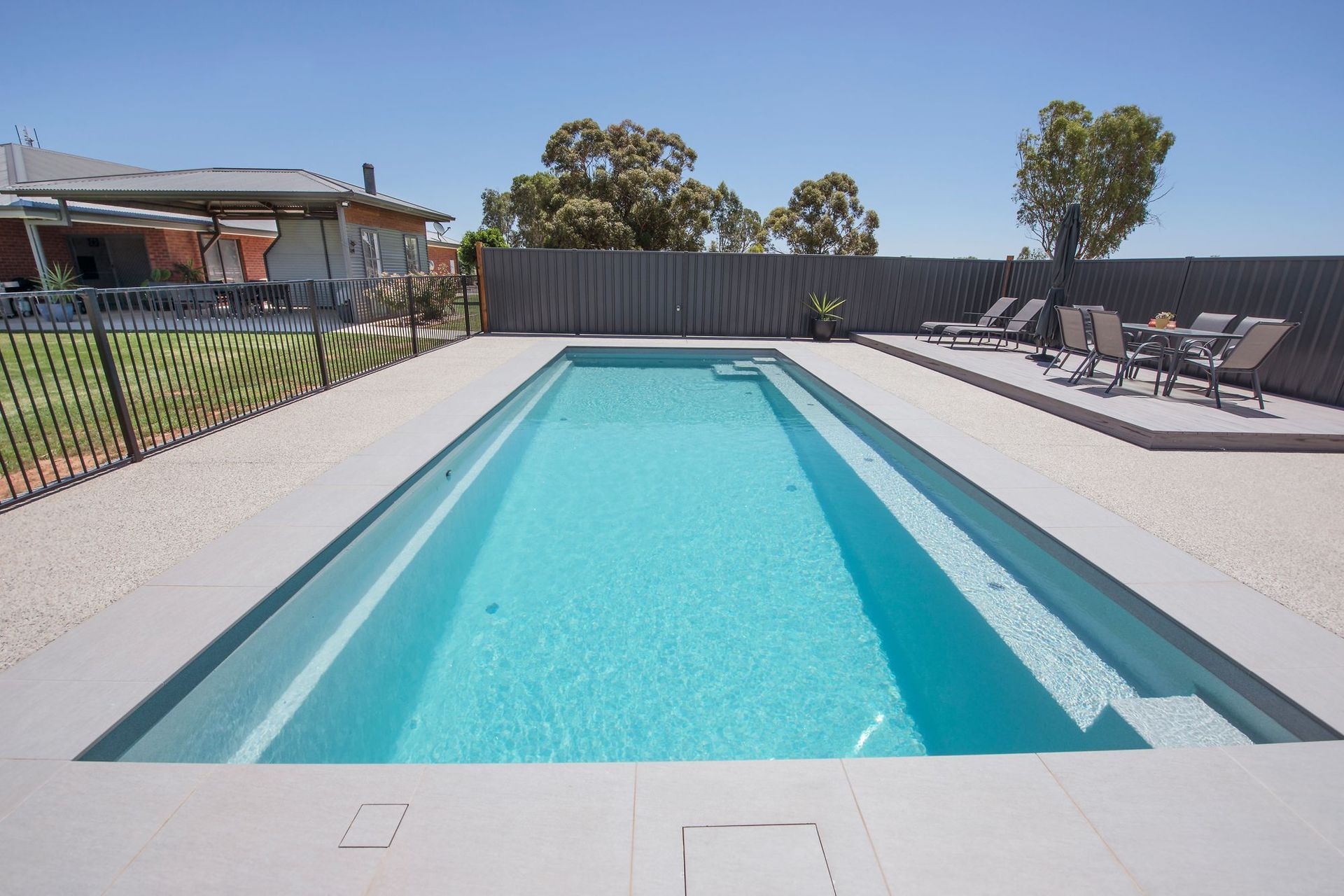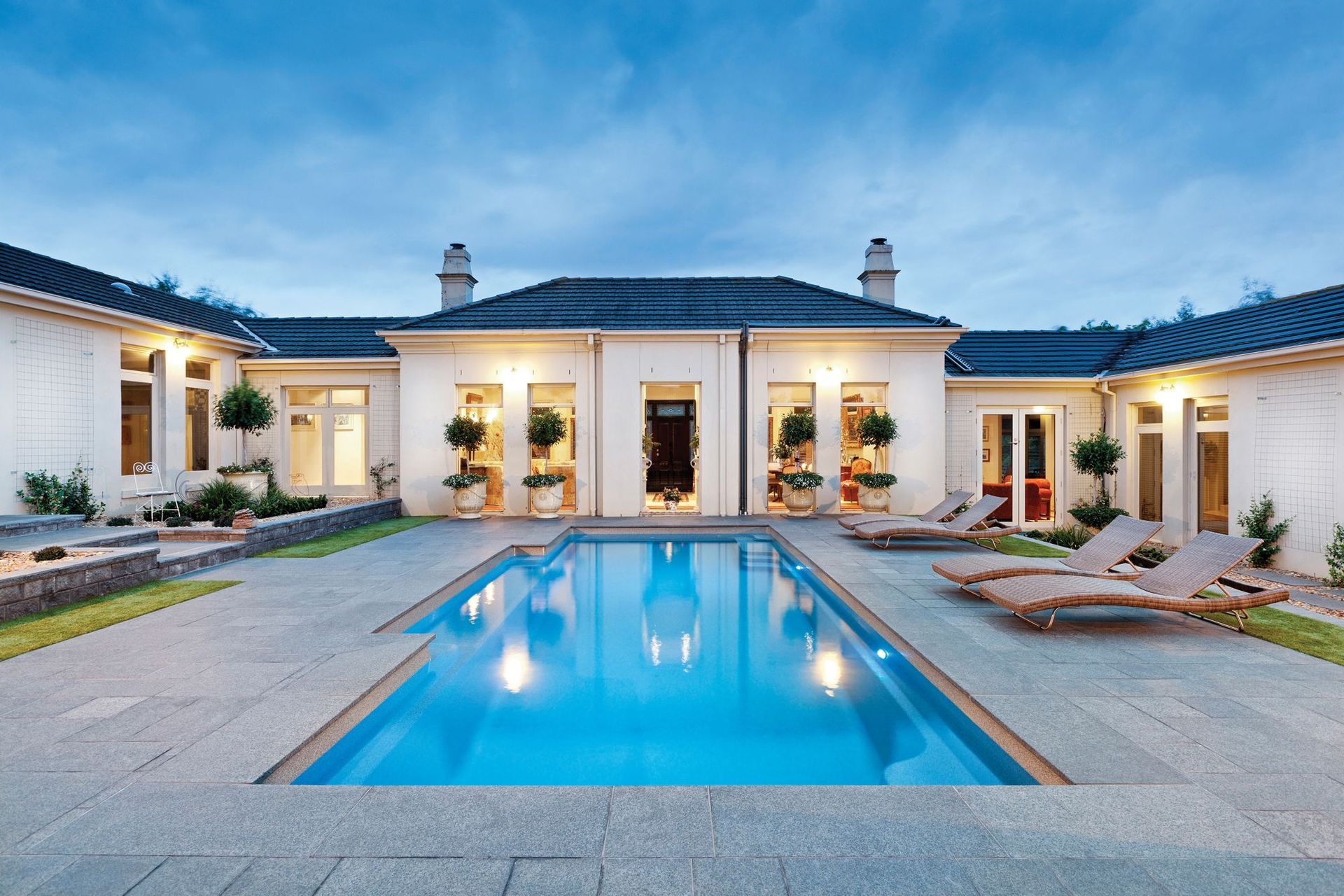Choosing the best pool for you: Concrete vs fibreglass pools compared
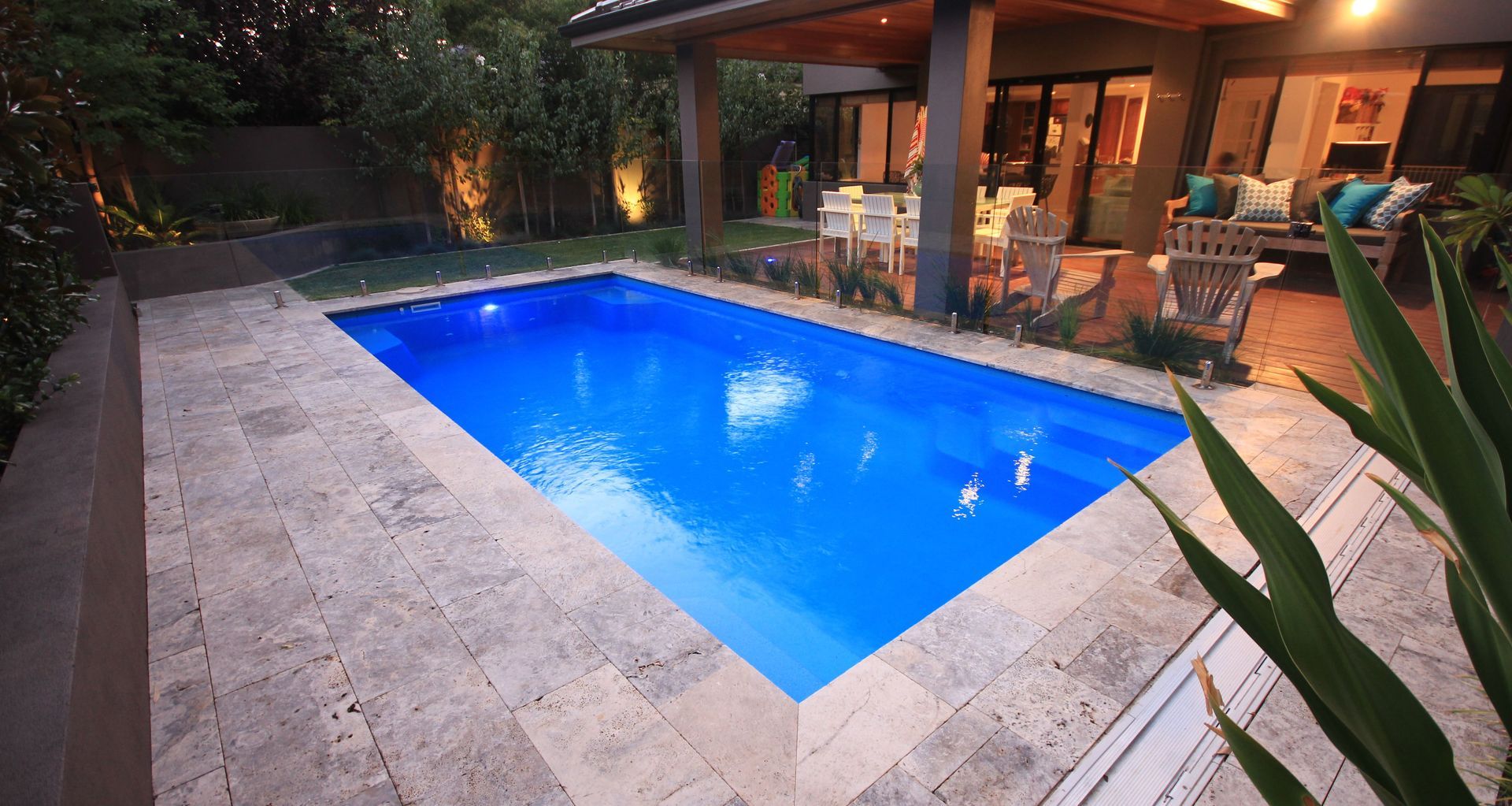
It can be tricky to find concise information that informs you why these two materials are popular, their advantages and disadvantages and how much they will cost. That’s precisely what we aim to do in this article, so by the end, you have all the information to choose the best pool for you.
Key takeaways
- Concrete pools offer extensive customisation and design flexibility but come with higher initial and long-term maintenance costs compared to fibreglass pools, which offer a smoother feel and quicker installation.
- Both concrete and fibreglass pools have the potential to last for 50 years or more with proper maintenance.
- Additional luxury features and technological upgrades can enhance the pool experience for both pool types, while considering installation and upkeep is essential for assessing the pool’s impact on property value and long-term investment.
1. Concrete swimming pools
The cost of a concrete swimming pool
The average cost of installing a concrete pool can range from $50,000 to $100,000. There are various key points that impact how much you’ll pay.
Design and construction method
A cast-in-place concrete pool, a more custom design, involves pouring concrete into a wooden or steel framework at the site and requires a framework to hold the concrete in place until it cures.
Precast concrete pools are constructed in a factory, pouring high-quality concrete into moulds to create the pool's structure. Once the pool is complete, it's then transported to the desired site for installation.
Size and depth
The size and depth of the pool, of course, affect price, with a general rule that the bigger the pool, the more it will cost. A small concrete pool can be defined as one that measures 6m x 3m; for a pool of this size, expect to pay at least $50,000. For a pool of around 10m x 5m and higher, expect to pay at least $65,000+.
Customisation and additional features
The more custom and additional features you include with your concrete pool the more it will cost. Standard features include the concrete shell, a basic plaster interior finish, coping around the pool edge, a pump and filter system, skimmer and return jets, plumbing for water circulation, built-in steps or benches for entry and exit and a main drain.
Additional features include:
- LED or colour-changing lights
- A pool heater or heating system
- Saltwater chlorination system
- Automated pool covers
- Waterfalls or fountains
- Custom finishes
- Diving boards and slides.
Site accessibility and preparation
Site accessibility refers to how easily construction equipment and materials can be brought onto the site where the pool is to be constructed. If the site is difficult to access, for example, due to narrow pathways, steep slopes, or obstacles, special equipment or methods may be needed to transport materials. This can lead to increased labour and equipment rental costs.
Site preparation involves readying the area for the pool's construction. This can include clearing vegetation, levelling the ground, and, in some cases, modifying the landscape with retaining walls to manage slopes or prevent erosion. Extensive site preparation work requires additional labour, machinery, and materials, which add to the project's overall cost.
Local labour and material costs
The cost of building a concrete pool is influenced by local labour and material costs, which vary by location. Higher labour rates in urban areas and varying prices for materials like concrete and steel can affect the overall cost. Professionals such as pool builders, excavators, plumbers, electricians, architects, and engineers may be involved, each contributing to the expense based on local rates and the complexity of the project.
Any reputable pool supplier should be able to inform you of the professionals required for your project.
Permits and regulations
The cost and complexity of constructing a concrete pool are also affected by the need to obtain permits and adhere to local regulations. The best advice we can give is that you should talk to your local council about approval requirements in your area and any natural conditions that may affect your future swimming pool. You may find that a geotechnical survey is required to show whether any factors can impact installation, such as unstable foundation soil.
Advantages of concrete swimming pools
Now you know the rough pricing pool we can dive into the advantages and disadvantages of the material.
Customisation
Plenty of customisation opportunities are available with concrete, particularly if you decide upon a cast-in-place concrete pool, as you can choose the size and shape of the design. Shapes and sizes include rectangular, kidney-shaped, L-shaped, circular, oval, and infinity pools.
Lifespan
Concrete pools with proper maintenance can last for over 50 years. As a material concrete is designed to be withstand various environmental conditions.
Versatility in finish and design
Different concrete swimming pool finishes include:
- Aggregate finishes (a mixture of cement, sand and water) decorated with river stones, beads
- Tiles - ceramic, stone and quartz are popular choices
- Plaster - a classic, smooth finish that can be dyed in various colours for a custom appearance.
Long-term cost efficiency
The upfront cost of a concrete pool is higher than a fibreglass pool, but when you consider that the pool should last you 50+ years, the investment begins to make more sense.
Positive impact on property value
The potential value a swimming pool can add to the value of your property shouldn't be ignore. According to data collected by the Sydney Morning Herald a swimming pool can add between $100,000 - $200,000 to a Sydney home. While these figures may not be reflective of the entire country, they are still worth taking into consideration.
Disadvantages of concrete swimming pools
Higher installation costs
As we've mentioned, concrete pools can cost between $50,000 - $100,000+. Of course, costs can be less or more than this depending on the size of the job. Your swimming pool supplier should be able to give you a more exact quote.
2. Fibreglass swimming pools
The cost of a fibreglass swimming pool
Fully installed fibreglass swimming pools can cost anywhere from $25,000 to $50,000+. Similar factors impact the price of fibreglass pools to those that affect concrete pools. Here's a look at them:
The design of the pool
Fibreglass pools tend to be above or below-ground pools. An above-ground pool is, as the name suggests, placed above ground. They are typically prefabricated and can be set up on a flat surface without the need for excavation.
As above-ground pools don't require excavation and are simpler to install, you can expect to pay around $6,000 - $20,000 for the fibreglass pool shell. Plus, at least $2,000 - $5,000+ for installation.
An in-ground (or below-ground) fibreglass pool is installed below the ground. Costs are higher for this design due to the need for excavation of a dedicated area, and it is considered a permanent structure. They offer a more traditional swimming pool appearance because they are integrated into the ground.
As in-ground pools require a more extensive installation process, you can expect to pay for the fibreglass shell, excavation and installation, which will be at least $10,000+. So, the total price for the shell plus installation for an in-ground pool can be estimated to be around $30,000 - $50,000+.
Related article: How much does a plunge pool cost in Australia in 2024?
Advantages of fibreglass swimming pools
Quicker installation times
Fibreglass pools are typically pre-manufactured, so the installation time is considerably less than their concrete counterparts. For an in-ground fibreglass pool the site will need to excavated, but the pool will arrive ready to be installed. As part of the excavation process a base will be installed, so the fibreglass shell can then be lowered and set into place, and the plumbing and filtration systems will then be connected. The entire process can take a few days to a few weeks.
If you're having an above-ground fibreglass pool installed the process will be even more straightforward providing the site is clear, and installation will likely take just a few days.
Low maintenance
There are a few reasons why maintaining a fibreglass pool is relatively straightforward. First of all, the gel coat surface is non-porous, which helps to reduce the growth of algae and bacteria, meaning that fewer chemicals are required to keep the water clean and balanced.
Second, the installation process is somewhat standardised, and the fibreglass shell comes pre-built and has undergone thorough quality checks before being shipped. One of the downsides of opting for a custom pool design and build is that you run the risk of ongoing maintenance being a little more complex due to the bespoke nature of the pool.
Energy efficient properties
Fibreglass swimming pools are energy-efficient due to their material properties. Its smooth surface reduces pump energy needed for water movement. Also, fibreglass's durability means fewer leaks and less frequent need for energy-intensive maintenance.
Related article: 11 creative pool fencing ideas that combine style and safety
Disadvantages of fibreglass swimming pools
Limited modification possibilities after installation
While the pre-moulded nature of most fibreglass pools has many advantages, one drawback is that pre-moulded pools can't be modified after installation. For instance, if you choose a pool of a specific height and depth and later want the pool to be bigger or one side to be deeper, the change most likely can only be accommodated by completely replacing the pool.
Prefabrication can limit shapes and sizes
Fibreglass pools are manufactured in a factory, and as such, they come in predetermined shapes and sizes. This prefabrication process can limit you to what is available in the manufacturer's catalogue. While there is a variety of designs available, if you're looking for a highly customised pool shape or size might find fiberglass pools too restrictive.
Concrete vs fibreglass: choosing the right material for your swimming pool
Concrete or fibreglass, which is the right material for your new swimming pool? There's no real right or wrong answer to this question. The choice heavily depends on the level of customisation you want, your budget, and how long you're willing to wait for installation. It never hurts to contact a few suppliers to get a range of quotes and opinions on what pool material is best suited to your specific situation. The most important thing to remember is that concrete and fibreglass pools can be fantastic additions to an outdoor space - you just have to decide on which material is best for you!
Browse a range of Australia's top swimming pool designers and builders on ArchiPro

